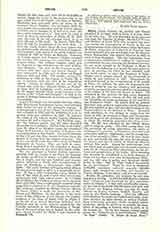

Seger, LOUIS GASTON DE, prelate and French apologist, b. April 15, 1820, in Paris; d. June 9, 1881, in the same city. He was descended on his paternal side from the Marquis of Segur—Marshal of France and Minister of Louis XVI, who occupied this position during the participation of France in the war of emancipation of the United States—from the Comte de Segur, companion of Lafayette in America, and on his maternal side was descended from the Russian Count Rostopchine who burned Moscow in 1812 to wrest it from Napoleon. After his humanities, from a comparative indifference to religion he experienced a remarkable fervor; entering the diplomatic service, he was made attaché to the Embassy at Rome in 1842, but the following year he left this post and even gave up painting, for which he had excellent taste and much talent, to enter the Seminary of Saint-Sulpice and to prepare himself for the priesthood, to which he was ordained in 1847. Thenceforth he dedicated himself to the evangelization of the people in Paris; the children, the poor, the imprisoned soldiers to whom he was the volunteer and gratuitous chaplain, occupied his ministry until he was appointed to be auditor of the Rota for France at Rome. He remained in this position for four years, honored with the affectionate esteem of Pius IX and with the friendship of many personages of the pontifical and diplomatic Court. He united with his judicial functions some political negotiations which Napoleon III had confided to him, and also ministrations to the French soldiers in the garrison at Rome. Attacked with. blindness, he was obliged to resign from his duties in 1856; he returned to Paris with the honors and privileges of the episcopate, the title and reality of which his infirmity prevented him from receiving. His life was devoted to his official duties and to religious works. The chief among these was the patronage of young apprentices, the union of workingmen’s societies, ecclesiastical vocations and seminaries, military chaplaincies, and the evangelization of the suburbs of Paris. To each of these works he gave unstintedly his time, his care, his preaching, his money, and that of others, of whom he asked it without false pride. Among his undertakings, and one which most occupied him, was the work connected with the St. Francis de Sales Association, for the defense and preservation of the Faith. After founding this devotion he established it in forty dioceses of France in less than a year after its foundation (1859), and was able also to gather and distribute 30,000 francs in alms. “Msgr. de Segur worked incessantly for its development. When he died it numbered 1,900,000 associates, collected annually 800,000 francs, and extended its activities and benefits to France, Belgium, Italy, Spain, and even to Canada.
Besides his apostolate and ministry he was also engaged in writing. In 1851 he published in a modest form “Reponses aux objections les plus repandues contre la religion”; it met with considerable success. At the time of his death 700,000 copies had been sold in France and Belgium without counting the many editions in Italian, German, English, Spanish, and even in the Hindu language. After his affliction with blindness his works multiplied noticeably; some were destined to make known or defend Catholic ideas concerning questions which occupied public attention; others to extend or to confirm his apostolate of preaching in forming souls to piety “or to the interior life. To the first category belong among others the “Causeries sur le protestantisme” (1898); “le Pape” (1860); “le Denier de Saint Pierre” (1861); “la Divinite de Notre Seigneur Jesus Christ” (1862); “les objections populaires contre l’encyclique [Quanta cura]” (1869); “Les Francs-Macons” (1867); “le Pape est infaillible” (1870); “l’Ecole sans Dieu” (1873). To the second class belong among others: “les Instructions familieres sur toutes les verites de la religion” (1863); “Notions fundamentales sur la piety (1863); “La piety et la vie interieure” (1864); “Jesus vivant en nous” (of which an Italian translation was put on the Index) (1869); “La piety enseignee aux enfants” (1864). One need not seek in these works vast learning or didactic discussions. The author did not strive for this; he intended his apologetic books for the people and for all who ignored religion. They were mostly brief pamphlets, vigilant, full of vivacity and spirit, written with frankness wholly French in a popular style, sprinkled with caustic irony and Parisian pleasantries. In his ascetical works he aimed above all to spread the true principles of Catholic spirituality in opposition to the old traditions of Jansenism and Gallicanism. His zeal was crowned with success; his little books attained numerous editions. Thus at his death there had been sold 44,000 copies of his “Instructions familieres”, his works “Le Pape”, “La Communion”, and “La Confession” were issued to the number of hundreds of thousands of copies. His complete works have been edited in ten volumes (Paris, 1876-7); since have appeared “Cent cinquante beaux miracles de Notre Dame de Lourdes” (2 vols. Paris, 1882); “Journal d’un voyage en Italic” (Paris, 1822); “Lettres de Msgr. de Segur” (2 vols. Paris, 1882).
ANTOINE DEGERT

